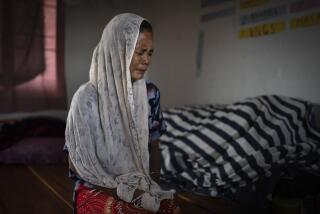Impoverished East Timor Plagued by Years of Death, Political Repression : Police state: Takeover by Indonesia has sparked a civil war that has killed thousands. Human rights groups say abuses are among the world’s worst.
- Share via
The poor, bloodstained former Portuguese colony of East Timor may be a lost cause.
East Timor has been in and out of international headlines since 1976, when it was brutally absorbed by Indonesia. The takeover triggered one of the world’s longest ongoing civil wars, leaving at least 100,000 dead and thousands more imprisoned or resettled into “strategic hamlets” by Indonesia’s military.
East Timor is situated on the distant eastern half of mountainous Timor Island, located at the southeastern end of the vast Indonesian archipelago. Culturally distinct, the Timorese people are predominantly Roman Catholic--a small Christian enclave in the most populous Muslim nation.
Terror exploded again Nov. 12 at Santa Cruz Cemetery in East Timor’s capital, Dili. Indonesian security forces opened fire on more than 1,000 mourners visiting the grave of a young independence activist who had been killed by soldiers in October.
The death toll in what was reportedly an unprovoked massacre is disputed. The Indonesian government, which expressed regret at the shootings and is investigating them, claims that 19 people were killed and 91 people were injured.
But Geoffrey Robinson of Amnesty International, the London-based human rights organization, says at least 100 people died and scores were wounded.
Amnesty International says the massacre, which it calls “appalling,” is “just the latest in 15 years of outrages in East Timor.”
Countless United Nations resolutions have condemned Indonesia’s takeover of Timor, but the de facto occupation has been tolerated because Western powers, including the United States, condoned it by ignoring it, Robinson says.
“East Timor will not be a lost cause if these nations are finally shocked into taking proper action,” he said. The United Nations has a mandate to resolve what many governments have viewed as the hopeless Timor situation.
The United States, which backs the U.N. mandate, believes that “nothing that may have taken place Nov. 12 could justify a military reaction of such magnitude with such a loss of life,” said a State Department spokesman.
Support for independence groups, which want free elections, has been more vocal in recent years, particularly during visits by world leaders such as Pope John Paul II, who came in 1989.
Human rights abuses often go unreported because the Indonesian government still restricts access to East Timor, which it had virtually sealed off for almost 14 years and opened to tourism and commerce only in 1989.
At least 30 people were killed by security forces in 1990 and early 1991 in “apparent extrajudicial executions,” Amnesty International reports. More than 400 people have been detained since late 1988 for pro-independence activities, and hundreds of disappearances remain unsolved.
In East Timor, the main mission of the International Committee of the Red Cross has been “to make regular visits to persons arrested and deprived of liberties and maintain contact with their families,” said Sylvie Junod of the organization’s New York office.
A Portuguese possession since the 16th Century, East Timor was a nearly forgotten remnant of the old empire until the Portuguese military seized power in Lisbon in 1974.
The Portuguese pulled out of East Timor, and civil war erupted. The Revolutionary Front for an Independent East Timor (Fretilin in its Portuguese acronym) prevailed over hastily formed rival political groups. In 1975, Fretilin declared independence.
Indonesian President Suharto said Fretilin was communist-controlled and warned of an “Asian Cuba.” His forces invaded East Timor, occupied it and proclaimed it Indonesia’s 27th province in 1976.
The consequences have been deadly. At least 100,000 people and perhaps as many as 200,000 have been killed in fighting or died of starvation or disease. East Timor’s 1975 population was estimated at 600,000 to 700,000.
Among the world’s worst cases of human rights violations, Robinson says, East Timor atrocities “have run the gamut of political executions, systematic tortures, mysterious disappearances in the middle of the night, beatings, imprisonments and unfair trials.”
In an enormous resettlement, tens of thousands of East Timorese were put in government-controlled “strategic hamlets,” where they were often unable to produce enough to stay alive.
Having meager resources, the Timorese people are scarcely able to support themselves on their largely arid end of the island. Subsistence farmers rely on maize. Coffee provides a limited cash crop.
But, in what could be considered potential economic exploitation, Indonesia and Australia have agreed to offshore oil and gas exploration in the Timor Sea.
Although the Indonesian government has built some schools and roads for the Timorese, a police-state climate pervades East Timor today, with a strong Indonesian military presence opposing Fretilin guerrillas in the hills and villages.
More to Read
Sign up for Essential California
The most important California stories and recommendations in your inbox every morning.
You may occasionally receive promotional content from the Los Angeles Times.










